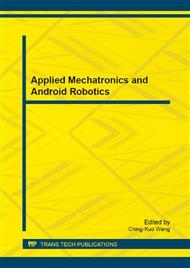p.3
p.10
p.15
p.20
p.25
p.29
p.34
p.38
Parameter Self-Adjusting Path Tracking Algorithm of Mobile Robots
Abstract:
For conventional fuzzy path tracking controller need to manually updated the control parameters in order to get better tracking control deficiencies and the lack of robustness of the problem when the control object is disturbed. Parameters self-adjusting tracking algorithm is proposed based on Cerebellum Model Articulation Controller(CMAC) and fuzzy logic composite of the control. The CAMC control logarithm first charged with tracking through learning objects charged with approximation of the object model, to learning cycle worth to control corresponding to the amount of correction corresponding weight value according to the error between input and output of the system and set the learning rate. When the object or environment changes can make the control performance of the system is automatically adjusting within a certain range, since the role of the CAMC. Tracking experiments show that. The tracking control algorithm has high tracking accuracy and good robustness, is conducive to the overall optimization of robot path tracking.
Info:
Periodical:
Pages:
10-14
Citation:
Online since:
September 2013
Authors:
Price:
Сopyright:
© 2013 Trans Tech Publications Ltd. All Rights Reserved
Share:
Citation:


